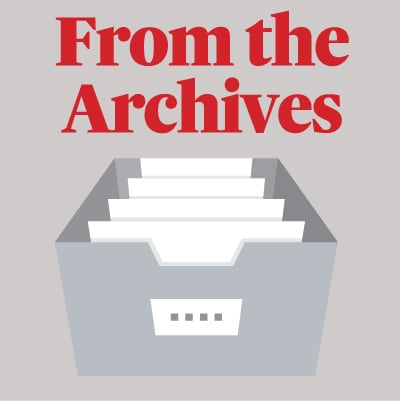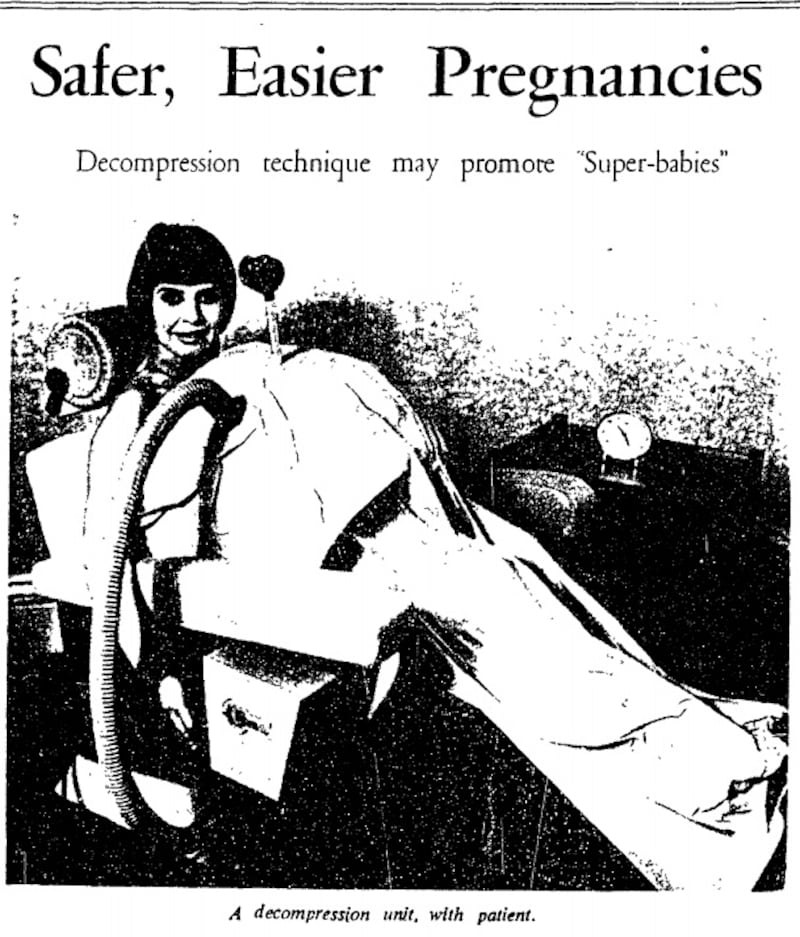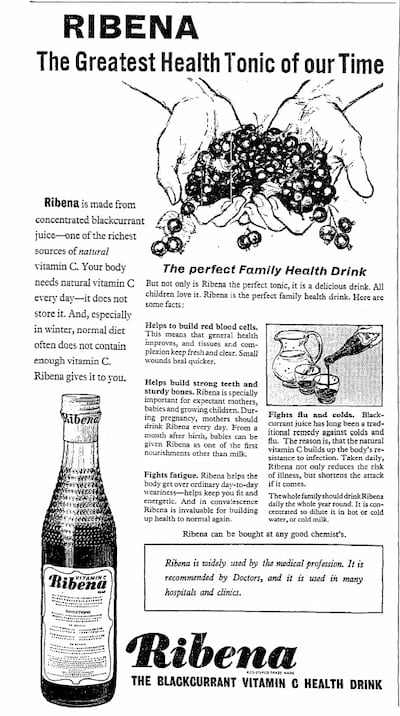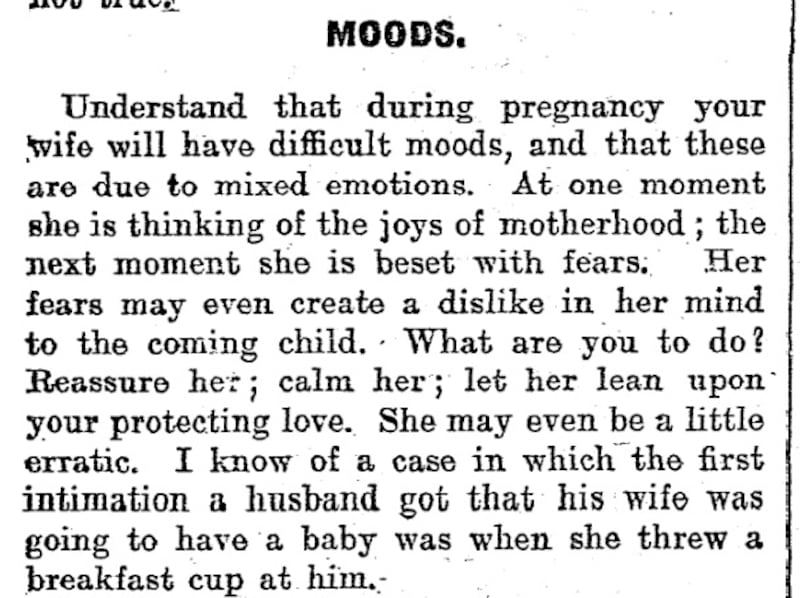Growing a baby in 2019 can bring a litany of symptoms, ailments and worries, so one can only imagine how more formidable it was when pregnancy was not considered a topic for polite public, or even private, discussion.

Aside from mentions of royal gestations, and miscarriages, a trawl through The Irish Times archive finds only a scattering of clues about the lives of expectant 19th century mothers. In 1875, women could write away for Dr VP Mulvaney’s Ladies Guide, which gave “instruction for both single and married life”. Or 10 stamps bought Dr Smith’s Woman; Her Duties, Relations, and Position, which covered subjects including Maidenhood, Courtship, Marriage, Motherhood . . .
Products were also advertised to treat nausea and sickness in pregnancy, such as seasickness remedy Navigantine and Du Barry’s Delicious Arabica Food in 1870. Downing & Co’s Magnetic Appliances claimed, in 1879, to be “good for ladies . . . during and after pregnancy; they will prevent heartburn and many forms of indigestions . . . and while the Belts give support to the spine and abdominal muscles the ferruginous and odic forces prevent mental depression.”
There was more veracity behind the 1910 assertion from Scotts Emulsion that it helped mothers “bear the strain of pregnancy and the heavy drain of suckling”. Made from Norwegian cod liver oil it pre-dated a 1935 League Of Nations’ report which emphasised the need for extra vitamin D, either as oil or irradiated products, during pregnancy.
Malnutrition and dietary deficiencies during pregnancy were regular themes. Rotunda Hospital research in the 1930s showed many patients were malnourished and anaemic. And in 1941 300 expectant Dublin mothers were fed daily by the St John Ambulance Brigade. “Despite the work of these dining-halls, social workers tell me that an increasing number of mothers in the city are definitely under-nourished, and, therefore, cannot hope to bear healthy children,” wrote a “Special Commissioner”.
In 1940, our medical writer recommended a variable diet for expectant mothers, including “fruit juice, eggs, milk and fish. Green foods contain iron, and they should be eaten to give their iron to the blood”.
However, a 1955 study at the Rotunda and Coombe hospitals discovered that between 25-30 per cent of pregnant women were anaemic and called for bread to be fortified with iron. Another survey in 1964 found expectant mothers ate insufficient protein, calcium, iron, thiamine and riboflavin.

According to Master of the Rotunda Dr Alan Browne: "Many pregnancy complications had a nutritional basis. Chief among them were anaemia, toxaemia and premature labour. Ireland had the highest congenital malformation rate in the world and this was the cause of many infant deaths. This had a social and economic basis, being most prevalent amongst the poorer classes."
Iron deficiency was also linked to the rare pregnancy symptom, pica. In 1959 “Our Medical Correspondent” noted a Swedish study where 100 patients with pica “were cured of the complaint in less than a fortnight by treatment with iron”.
“I have known two cases in my own practice of expectant mothers with an inordinate longing to eat soap,” he wrote. “In each case, the craving, which was frequently gratified, was specifically for a well known proprietary brand of carbolic soap.”
Another patient he knew had a yearning for coal, “. . . she had uncomfortable memories of going down to the coal-cellar for a few choice Orrel Nuts when the household was asleep, just as others might ‘raid’ the refrigerator”.

Advertisers recognised the potential of nutritional concerns during pregnancy. In 1958 Ribena was marketed as “The Greatest Health Tonic of Our Time”, including claims it was “specially important for expectant mothers” who should drink it daily. However, what is more outlandish, even without the benefit of six decades’ hindsight, is its assertion: “From a month after birth, babies can be given Ribena as one of the first nourishments other than milk.”
Symptoms of pregnancy discussed – or targeted by advertisers – included varicose veins, indigestion and constipation. In 1896 Apenta aperient water was recommended during pregnancy; in the 1960s mineral rich water had been replaced by Milpar.
New research, and potential risks to pregnant women, were publicised, including rhesus factor, eclampsia, diabetes and prescribed drugs. And as early as 1959, a study concluding that smoking retarded foetal growth.
A 1968 article focused on "decompression" in South Africa. "A vacuum pump (the same as used in household vacuum cleaners) lifts about half a hundredweight of pressure off the womb . . . ". Decompression was used to treat toxaemia, ease labour, and doctors claimed it "improves the 'quality' of the child physically and mentally".

There was advice too for expectant fathers. In 1933, Dr Charles Thompson instructed them on their duties: "See that your wife gets good wholesome food; not too much meat; plenty of vegetables. She should wear loose, comfortable clothing . . . Be sure and accompany here when she goes out for her evening walk; she needs company. Don't let her overtire herself. At home try and reverse things a bit. Make her a cup of tea. Learn how to make a fire. Don't let the wife lift heavy weights. You do the wood-chopping and you carry in the coal scuttle. Remember that she is carrying a growing baby, and this makes demands upon her physical and mental energy."
Dr Thompson was particularly stringent on one topic: “If you don’t follow my advice, and take your wife to see the doctor to get ante-natal examination, care and supervision, from time to time, you deserve to get locked up in prison.”
Free access to antenatal and maternity care was finally introduced in 1954 – a diluted version of what had been proposed by Noel Browne’s Mother and Child Scheme, due to opposition from the Catholic and medical hierarchies. However, even despite this access, in 1967 just 3 per cent of women attended a doctor in the last month of pregnancy and 6 per cent in the final two.
To conclude, some prenatal advice from 1950 to irk, rather than aid, pregnant readers. In "When Charm is Needed Most", writer Ann Douglas described pregnancy as a time a mother to be "should surround herself with a warm and happy atmosphere".
“But”, she asked, “how many women become irritable, nervy and let themselves go? They forget their wonderful plans and become whining, neurotic and unattractive . . .
“Choose exactly the right time to tell your husband. Tell him . . . that you are determined to make this a happy, joyful time, but that you know he will understand and help you if you are sometimes rather tired or nervy. He will love you all the more for this little confidence and appeal for his help.”










